Trees Birds Mammals Fish Amphibians Reptiles
Wild Algarve
Bookshop
Lactarius quietus (Fr.) Fr. - Oakbug Milkcap
Phylum: Basidiomycota - Class: Agaricomycetes - Order: Russulales - Family: Russulaceae
Distribution - Taxonomic History - Etymology - Identification - Culinary Notes - Reference Sources
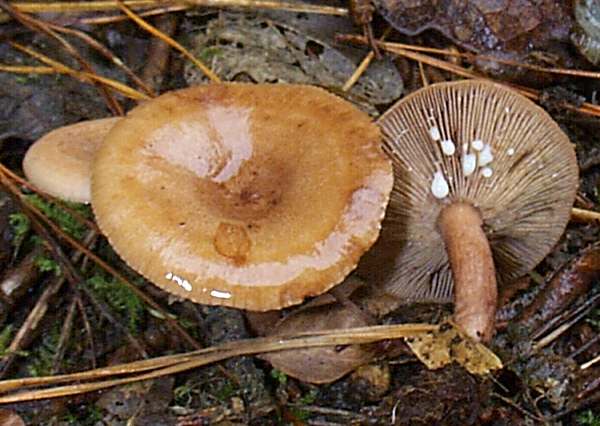
Lactarius quietus, the Oakbug Milkcap (also referred to simply as the Oak Milkcap), appears in
great abundance beneath oak trees even in areas where the soil is thin. Even on steep slopes where rainwater runs off quickly, it is worth looking out for these gregarious milkcaps among the leaf litter.
Distribution
Very common and widespread in Britain and Ireland, the Oakbug Milkcap is also found on mainland Europe and in parts of North America.
Taxonomic history
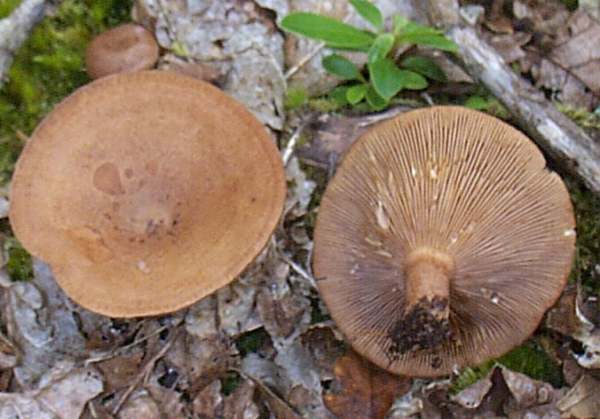
The Oakbug Milkcap was described in 1821 by the great Swedish mycologist Elias Magnus Fries, who gave it the binomial scientific name Agaricus quietus, but in 1838 Fries himself transferred this species to the genus Lactarius, thereby establishing its currently-accepted scientific name as Lactarius quietus.
Synonyms of Lactarius quietus include Agaricus quietus Fr., Galorrheus quietus (Fr.) P.Kumm., and Lactifluus quietus (Fr.) Kuntze.
Etymology
The generic name Lactarius means producing milk (lactating) - a reference to the milky latex that is exuded from the gills of milkcap fungi when they are cut or torn. The specific epithet quietus comes from Latin and means quiet or calm, which is almost certainly a reference to the easily overlooked or quiet colouring of this mushroom.
Everything about the Oakbug Milkcap seems to suggest that this undistinguished mushroom must be very difficult to identify; in fact it is one of the few milkcaps that once you have seen them are thereafter instanty recognisable. The Oakbug Milkcap is, in this respect, very much like Major Major in Joseph Heller's famous novel Catch 22: so undistinguished that it stands out from the crowd as more undistinguished than any of the others. Unfortunately, however, these little milkcaps do not stand out from the leaf litter.
Identification guide
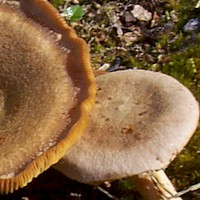 |
Cap
4 to 9cm in diameter, convex and then
slightly depressed, the caps are yellow-brown to reddish-brown with subtly faint
darker concentric zones.
In wet weather the caps are shiny, but they dry to a dull matt finish. |
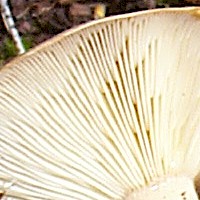 |
Gills
Shortly decurrent, crowded and creamy-brown or
pinkish yellow, the gills exude a mild-tasting creamy-white milk when they
are damaged. As the fruiting body ages, the gills become noticeably more
brown.
Stem
5 to 10mm in diameter and 5 to 7cm tall, the cylindrical stem is the same
colour as the cap but shading slightly darker towards the base. There is no
stem ring. |
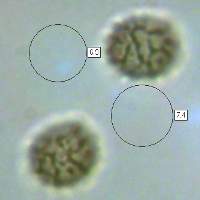 |
Spores
Broadly ellipsoidal, 8-9 x 7-7.5µm; ornamented with low warts (0.5-1um) joined occasionally by ridges and with a small number of cross connections that form a few 'zeds' but not a complete reticulum.
Spore print
Pale creamy-white with a slight salmon pink
tinge. |
Odour/taste |
A rather unpleasant oily smell (of bedbugs, according to traditional wisdom); the milk (latex) has a mild
taste, becoming slightly bitter after a while. |
Habitat & Ecological role |
Mycorrhizal with oak trees. Although Lactarius quietus could be confused with several other
medium-sized pale brown milkcaps, the fact that it occurs only under oak
trees is a great help in identifying this species. (When recording foray
finds, it is always useful to note the tree species beneath which
mushrooms occur, since this information often proves useful in eliminating
lookalikes during the identification process.) |
Season |
August to October in Britain and Ireland. |
Similar species |
Lactarius rufus is larger and darker and usually has a
central umbo; it occurs under conifers and occasionally birch and
releases a bitter latex when the gills are damaged. |
Culinary Notes
Lactarius quietus is generally regarded as an edible mushroom. The milk (latex) from the Oakbug Milkcap is mild, but unfortunately Lactarius quietus is not a particularly pleasant-tasting mushroom, which is a pity in view of its great abundance and
widespread distribution.
Reference Sources
Fascinated by Fungi, 2nd Edition, Pat O'Reilly 2016, reprinted by Coch-y-bonddu Books in 2022.
Funga Nordica, Henning Knudsen and Jan Vesterholt, 2008.
Fungi of Switzerland, volume 6: Russulaceae, Kränzlin, F.
BMS List of English Names for Fungi.
Dictionary of the Fungi; Paul M. Kirk, Paul F. Cannon, David W. Minter and J. A. Stalpers; CABI, 2008
Taxonomic history and synonym information on these pages is drawn from many sources but in particular from the British Mycological Society's GB Checklist of Fungi.
Top of page...
Fascinated by Fungi. Back by popular demand, Pat O'Reilly's best-selling 450-page hardback book is available now. The latest second edition was republished with a sparkling new cover design in September 2022 by Coch-y-Bonddu Books. Full details and copies are available from the publisher's online bookshop...